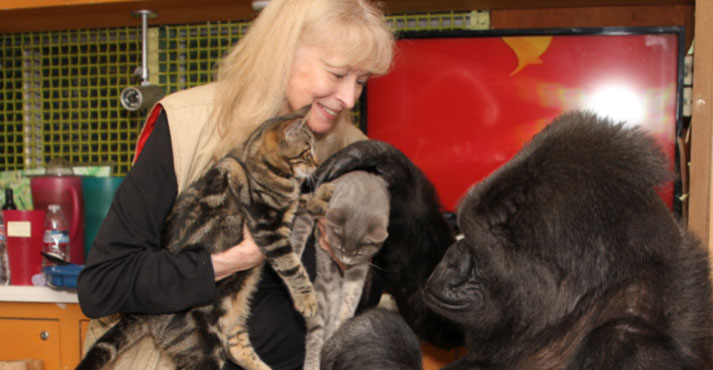At the Gorilla Foundation, the gorillas guide their own care. Koko and Ndume communicate with our caregiving team through a combination of American Sign Language and other modes of communication, which enables us to fully utilize 2-way communication to optimize their care and enrichment. Gorillas are emotionally and cognitively complex, and hence can indicate clearly what they need and want, if we just give them the opportunity.
For example, Koko may ask a caregiver, in sign language, to read one of her favorite books or have a visit from her two new cats. And Ndume may ask for a special treat, by pointing when given a selection of options, or ask to play a game of chase by clapping (his gesture for “chase”).
At The Gorilla Foundation, we combine the best of both worlds – gorilla and human – to provide personalized care for Koko and Ndume, using:
• The gorillas’ communication abilities, which include this growing list:
o American Sign Language
o Natural gorilla gestures (clapping, kissing, pointing …)
o Natural gorilla vocalizations (purring, barking …)
o Comprehension of spoken English
o Charts (e.g., multiple-choice, picture, or graded bars)
o Picture selections from books, magazines and DVD cases
o Manipulation of toys & dolls (e.g., Koko molding a doll’s arms to sign)
o Directed-gaze selections
o Pre-printed phrase cards (which they select and arrange)
• The Gorilla Foundation’s 40 years of cumulative gorilla care experience
• The Gorilla Foundation Team — which includes fluent ASL signers, two of whom
have communicated with both chimpanzees and gorillas
• Expertise provided by our gorilla veterinary team, AZA colleagues, and
Stanford Medical School consultants
• Exploration of new gorilla-friendly computer interfaces for self-expression
 The comprehensive use of interspecies communication facilitates the development of strong bonds between gorillas and caregivers, and greatly enriches both their lives and ours. For example, it is not uncommon for gorillas Koko and Ndume to ask for their favorite caregivers (Koko has a sign for each caregiver, and Ndume “kisses” to get a particular caregiver’s attention). As a caregiver, I work closely with my team to communicate and fulfill Koko’s and Ndume’s requests, when practical and appropriate This builds trust and cooperation, and gives us further insight into their needs and wants.
The comprehensive use of interspecies communication facilitates the development of strong bonds between gorillas and caregivers, and greatly enriches both their lives and ours. For example, it is not uncommon for gorillas Koko and Ndume to ask for their favorite caregivers (Koko has a sign for each caregiver, and Ndume “kisses” to get a particular caregiver’s attention). As a caregiver, I work closely with my team to communicate and fulfill Koko’s and Ndume’s requests, when practical and appropriate This builds trust and cooperation, and gives us further insight into their needs and wants.
Koko and Ndume have experienced this kind of empathy-rich care throughout most of their lives, here at the Gorilla Foundation. They are treated as equals — in terms of their right to have their needs and wants heard and thoughtfully attended to. We ensure that the care they receive is no different than the care we would provide our own loved ones -—unconditional, unwavering, and everlasting
by pointing to it when we give him choices.” class=”caption” alt=”” />
We’ll be sharing many more examples of “gorilla-guided” care on our blog. Please subscribe to our email newsletter to get all of our blog posts and updates.
 |
Sophia Gruskos is a Gorilla Caregiver / Research Assistant at The Gorilla Foundation. She developed a great love and respect for nature and wildlife at a very young age, studied American Sign Language at the Santa Fe Community College and later received her B.S. in Psychology from the University of New Mexico, with an emphasis in Primatology. She has participated in behavioral research and observation for both captive and wild primates, and believes that Koko and Ndume are ambassadors for young people as well as gorillas. |


